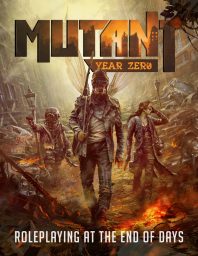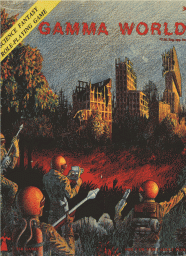
 For the better part of the year I’ve been playing in a Mutant: Year Zero game. And, now, since I recently started playing a new game of Gamma World (run by and covered by Jeffro Johnson here) I reckon it makes some sense to do a short bit of compare and contrast.
For the better part of the year I’ve been playing in a Mutant: Year Zero game. And, now, since I recently started playing a new game of Gamma World (run by and covered by Jeffro Johnson here) I reckon it makes some sense to do a short bit of compare and contrast.
Thematically both games are extremely similar. Both feature roleplaying set in a post-apocalyptic future population by humans with mutant powers and a hostile environment made up of radiation, poison, rogue killer robots, rival tribes and mutated hostile animals. And, it’s no wonder why this is so. Gamma World was first published in 1978 and the parent game that inspired Mutant: Year Zero, simply entitled Mutant, was published in 1984. These were years of high cold war tension, thousands of US and USSR city buster nuclear warheads aimed for Mutual Assured Destruction. The world seemed poised on the brink of sudden death and the future looked bleak as hell. So, the origins of both Gamma World (GW) and Mutant: Year Zero (MYZ) stem from a widespread anxiety common of the time.
But, MYZ is not the original Mutant but, a licensed RPG inspired by it dating from 2014. I have never seen, read, or otherwise interacted with the original Mutant rules so, I can’t speak to the original but, MYZ is a thoroughly modern affair. So how do the two games stack up?
Mutant Powers. In GW, each character rolls for up to 4 each of physical and mental mutations. GW mutations can be either beneficial or detrimental. For example, my character, Twitchy Henry, rolled the maximum four each for mental and physical mutations and got: heightened strength (+3 dice physical attacks), Hemophilia (-2 hp/round after first wound until bound), double physical pain (doubles all damage to character), diminished sense (I rolled randomly and got smell), epilepsy (DM to decide consistent set of triggers), reflection (reflects damage received at a cost of no movement or action), teleportation (up to 30 km, if no 8 hour study of location then 25% chance of 10d6 damage), heightened intelligence (+4 int and -2 when trying to figure out artifacts). So, a smart and strong, epileptic sensitive bleeder. Note also that the combinations of mutations inspire story telling: maybe the teleportation and reflection powers are a compensation for knowing how vulnerable he is with the combination of both hemophilia and double physical pain? One of the wonderful things about GW is the how unpredictable combinations of mutant powers interact with one another. Another character I rolled is a mutant deer, Takbok Charlie. Charlie has a number of mutations including the combination of anti-reflection and de-evolution. Anti-reflection is a detrimental power that means that whenever a mental mutation is used there is a 25 percent chance that the power will affect the character rather than the target. De-evolution is a mental power that strips the most effective mutation off the target. In combination, I figure that eventually Takbok Charlies will end up a normal deer which I find to be rather poetic — both melancholy knowing the character may one day be the source of his own doom and joyous, mutant heal thyself. This is an effect that I highly doubt was planned from the start but, is just a charming circumstance of rolling random powers.
In MYZ each character starts with exactly one mutant power drawn from a deck of powers. All powers are beneficial. There is a game mechanism for acquiring additional powers but, after the better part of a year playing, nobody in our party has managed to trigger the necessary event. However, each power does include multiple related effects. For example, my character Don the dog handler, drew the Mind Terror power. This can be used to sow confusion and doubt into peoples’ minds or to create a convincing illusion in a single person’s mind. Mutant powers are activated by the expenditure of Mutant Points which are acquired in play. But, if the Mutant Points are available the use of a Mutant Power is guaranteed to be successful. The upshot of this is Mutants can be extremely deadly when they are charged up with Mutant Points. For example, in our last session, my character who had infiltrated a big bad’s cult, killed off the big bad in a single round by expending the Mutant Points I’d saved up. Basically, I Mind Terrored him into catatonia and after that he was helpless. It hasn’t happened in our sessions but, a group of players and NPCs who have a lot of Mutant Points will be true carnage. This feature of mutant powers means that at vary points in the game whichever character happens to have a supply of mutant points saved up becomes exceedingly the center of attention in a party but, once the points are expended that attention moves to someone else. This creates a very natural rotation of focus between all the players and is something unique in my experience with role-playing games.
The other interesting contrast is setting. Both GW and MYZ are not setting specific but, carry it out in different ways. GW is a true sandbox. It is up to the GM to come up with all setting details but, the system does provide an extensive set of random tables for encounters and in finding artifacts. GW is very flexible and gives the GM a huge amount of leeway to create the world and the ways for characters to interact with it. MYZ on the other hand, gives options for setting: either a post-apocalyptic London or New York City. But, really, it would not be too hard to come up with another site (e.g the Seattle Doomsday Map would work quite well). Whatever map you choose, the characters pick a spot for the location of their Ark. The Ark is a site where their little mutant tribe lives. The players help map their own Ark and also map the relationships between people in it. The Ark is the nexus of activity and the base from which characters explore. Each session play starts with players choosing project to work on the develop their Ark. For example the Ark we are playing in have completed a variety of projects to upgrade our Ark. We have built basic defenses, planted crops, a pigsty, a waterwheel & Mill, formed a militia, and built both a temple and a zone wrestling ring (think Thunderdome). These projects are contribute to building up the Ark’s food supply, culture, technology, and war capabilities. Our current uncompleted projects are creating Ink and Paper as well as rebuilding the temple that was destroyed in an earthquake. So, play starts working on projects and picking new projects. The GM the draws a threat from a deck of threats and play commences from there – often leading to expeditions out into the zone. The Zone is the rest of the map and play there very much resembles GW in that there are environmental encounters, mutated beasts, and artifacts to recover. But, the artifacts differ a lot from those in GW. First each artifact has two effects and the players must choose between keeping the artifact and using its effect for personal gain or contributing it to the Ark where it can boost the Ark’s stats. For example, a character might find a Tuxedo. The Tuxedo can be worn by a character, gaining them better social standing or contributing to the Ark and increasing the Ark’s culture. The effect of this mechanism is a push and pull between personal and group gain. Natural player selfishness of mitigated by competing gains within the Ark. Thus far, most of the artifacts acquired in our group have been contributed to the Ark. While the MYZ setting isn’t specific, there are very explicit mechanisms designed right from the start to create a society and create drivers for players to contribute to it. It works pretty well and it is somewhat startling the emotional attachment players can have to their Ark. In the last session the previously mentioned heavy my character killed was actually one of the bosses in the Ark with which my character had been aligned. Unfortunately, the boss went mad and initiated a scheme to destroy the Ark so he had to be stopped. But, it was quite a struggle to betray the NPC that had been my characters supporter and afterwards quite melancholy. Another, similar effect, was the player outrage when the earthquake destroyed our temple. Outrage that was immediately followed by vows to rebuild it better than before.
Overall, I find myself loving both games. Gamma World is wild and wooly and unpredictable. It’s a wide open space that is exactly what the players and GM make of it. Mutant Year Zero is also wide open, the Ark and Artifact mechanisms create a remarkable sense of place and the mutant power mechanisms create a real natural flow of focus to each player. But, this sense of place is also more claustrophobic. The Ark is a society and the characters are enmeshed in it. Mutant: Year Zero characters don’t feel quite as free as those in Gamma World and there is nothing quite like the zany and un-predictableness of Gamma World mutations. Both are excellent games and also good examples of how the same theme can be carried out to quite different effects. While, this may be too extreme a comparison, it’s the difference between The Road Warrior and The Road.
Another character I rolled is a mutant deer, Takbok Charlie.
Decades ago when I played Gamma World 1st edition, I rolled up my first character and it was a mutant deer. It was awkward for him to use human weaponry, particularly because he was 8 meters tall thanks to mutation.
I never thought anyone else would pick a deer for their mutated animal but I now see there is indeed another keen intellect out there in the universe.
Next time I play Gamma World I will be rolling up a mutated warlike manatee.
-
Takbok Charlie also rolled high metabolism requiring him to eat all the time. I figure he’ll be easy to track as he grazes huge swathes of vegetation wherever he goes. Has to stop and graze during combat.